Family : Chaetodontidae

Text © Giuseppe Mazza

English translation by Mario Beltramini
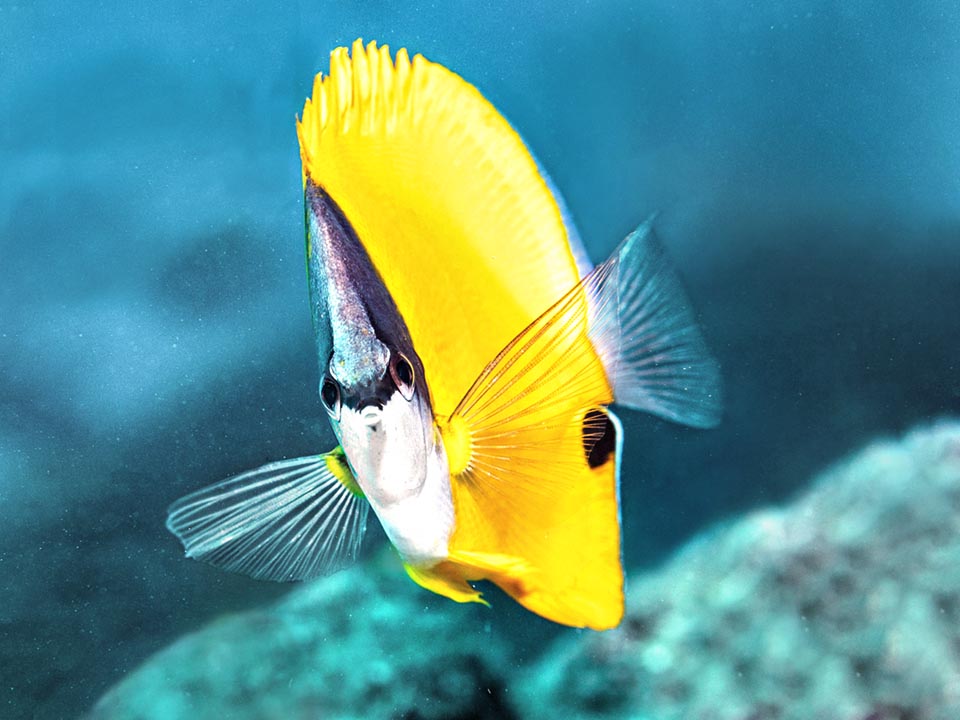
Within butterflyfishes, Forcipiger flavissimus has the widest distribution in the tropical Indo-Pacific, with more than 100 million of square kms © Allison & Carlos Estape
The showy Longnose butterfly fish (Forcipiger flavissimus Jordan & McGregor, 1898) belongs to the class of the Actinopterygii, the ray-finned fishes, to the order Perciformes and to the family of Chaetodontidae.
The name of the genus Forcipiger comes from the Latin “forceps”, tongs and “gero”, carry, in other words, it is a “fish carrying the tongs”.
The name of the species flavissimus refers, in Latin, to its showy yellow livery.
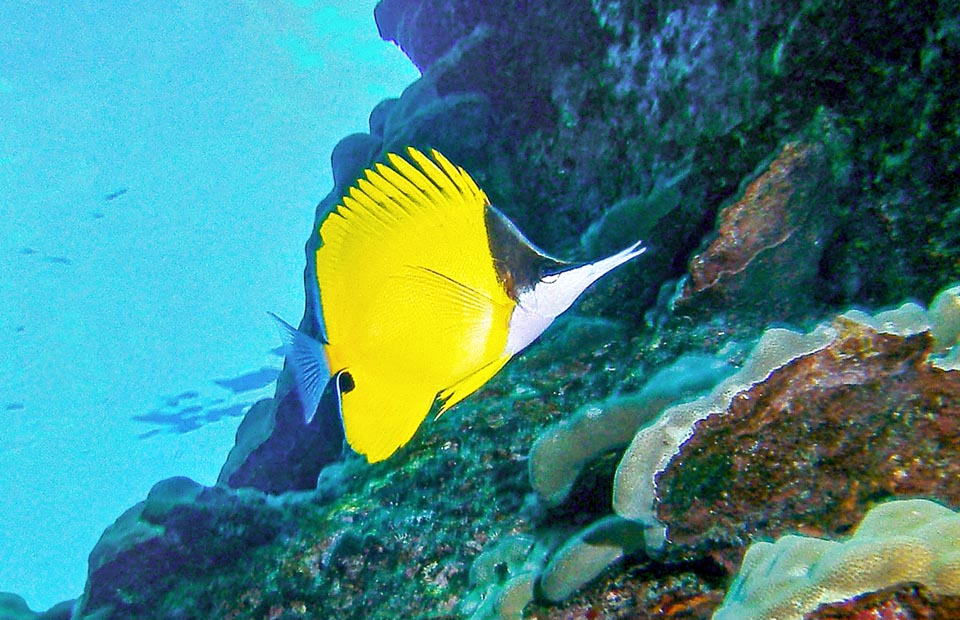
Up to 22 cm long is recognised due to its bright yellow colour, the triangular mask of head and the forceps long snout for seizing small prey in their shelters © Barry Fackler
For years, it has been confused with the Longnose butterflyfish (Forcipiger longirostris Broussonet, 1782), a virtually identical species, but with the snout one and a half longer, the chin adorned by a black dotting, closer mouth and 1-2 spiny rays less on the dorsal fin.
Zoogeography
It is the butterfly fish with the amplest distribution, exceeding the 100 million of square kilometres, in the tropical waters of the Indo-Pacific. Just as an indication only, we find it from South Africa and Madagascar, to the Gulf of Aden and the Red Sea, to the Maldives, India, Sri Lanka, Thailand, Australia, Indonesia, New Guinea, Micronesia, Philippines, Taiwan and China up to southern Japan.
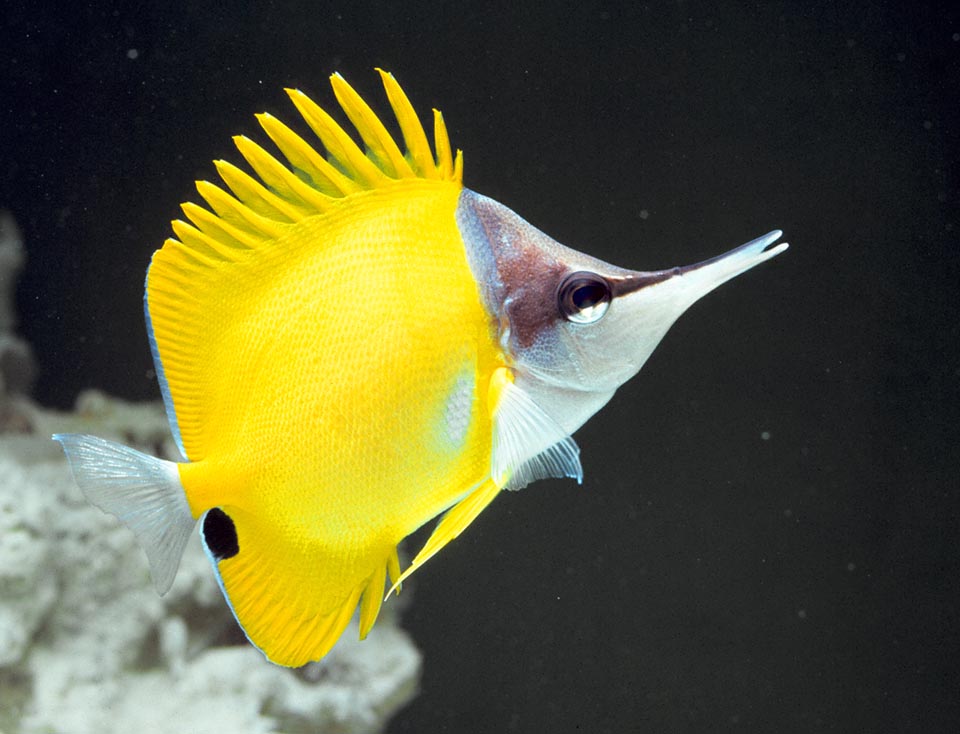
It has a double, Forcipiger longirostris who however swims the mouth shut, has 1-2 rays less on the dorsal, the black dot chin strap and a one and a half longer snout © Giuseppe Mazza
In the southern Pacific, it reaches Lord Howe and Easter Islands; eastwards, up to the Hawaii, the Galapagos and even Mexico and the southern part of the Gulf of California.
In Hawaii they call it “Lauwiliwili nukunuku ‘oi’oi” that means “fish with long snout shaped like a leaf of wiliwili”. As a matter of fact, the name “Lauwiliwili” refers to the resemblance between the shape of the body of the fish and that of a leaf of the tree wiliwili (Erythrina sandwicensis, leguminous plant endemic to Hawaii) that is oval and gets yellow as it ages, whilst the names “nukunuku” (snout) and “oi’oi” (sharp) indicate the narrow and long mouth of the fish.
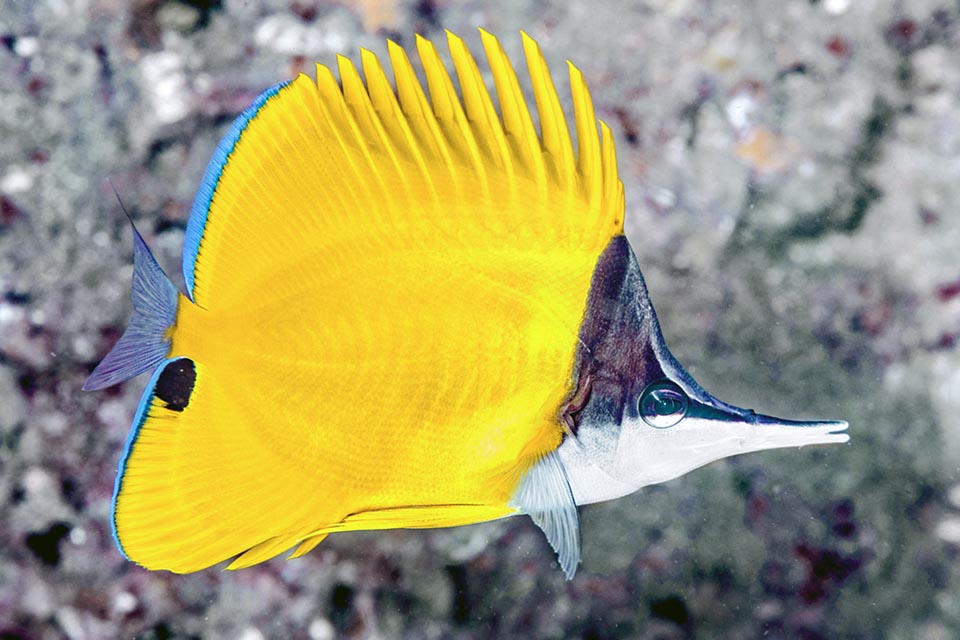
May reach almost 150 m of depth, nibbling hydroids, polychaetes and the pedicels of the sea urchins, looking for small crustaceans, eggs and larvae of fishes © Allison & Carlos Estape
And indeed, when these leaves carried by the wind fall into the sea, the divers at times mistake them for a Forcipiger longirostris.
Ecology-Habitat
It lives in the madreporic formations, also on the outer sides of the reefs up to about 150 m of depth, but may be found even in just 2 m of water. Gregarious in small schools when young, later often gets territorial and emits sounds to keep away the congeners.
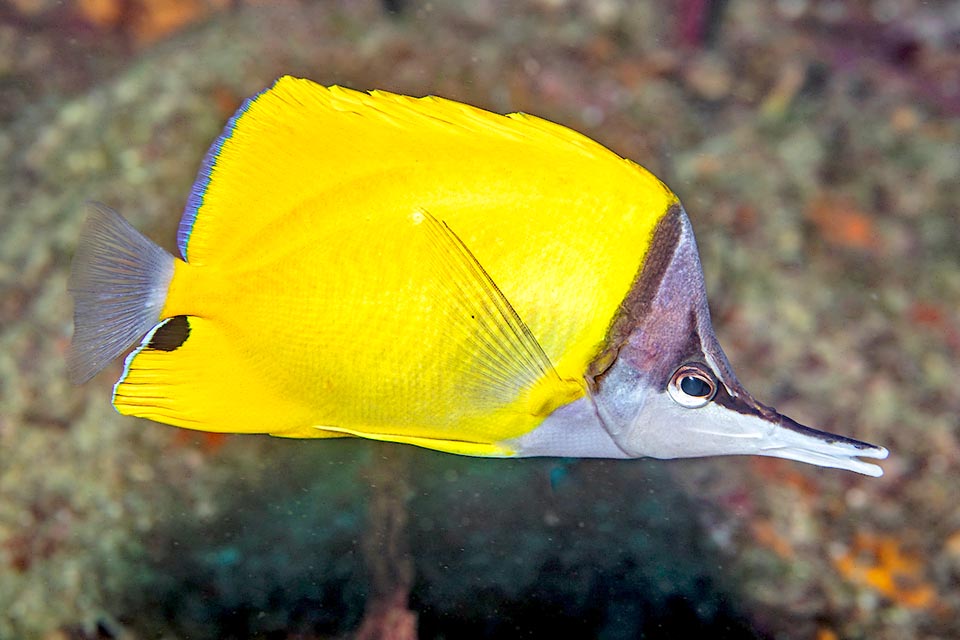
With folded fins it looks like a yellow rectangle. The head disappears broken neatly by the vertical dark edge of the mask and by the symmetrical white triangle below © Allison & Carlos Estape
Morpho-physiology
With the beak, it can reach the 22 cm. The body is flat, high, and more or less oval, with the oblique dorsal profile of the head ending in a long snout.
The tiny mouth has three rows of teeth on each jaw which allow the seizure of small preys.
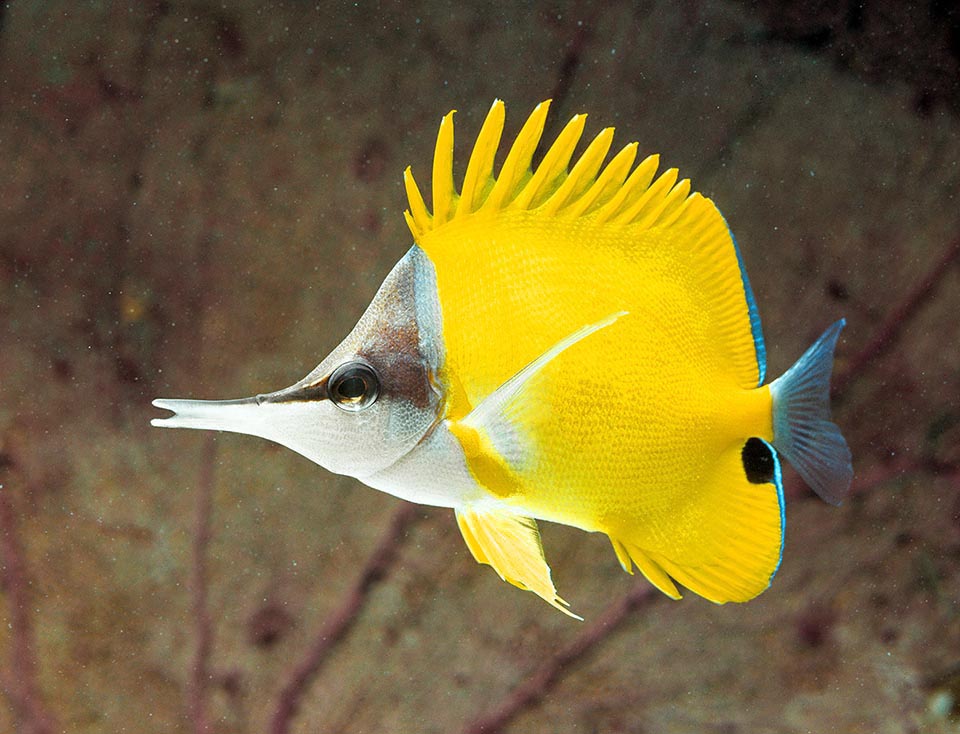
There is a black fake eye by the tail to further confuse the ideas to the predators, and when is obliged to confront spreads all its defensive fins also to appear bigger © Giuseppe Mazza
The dorsal fin has 12-13 spiny rays and 19-25 soft; the anal has 3 spiny rays and 17-19 soft; the ventral ones 1 spiny ray and 5 soft.
The pectoral fins are unarmed and the caudal is more or less blunt.
It has a nice bright yellow colour, but the head having a dark brown triangle above, hiding the eye, and a white triangle below.
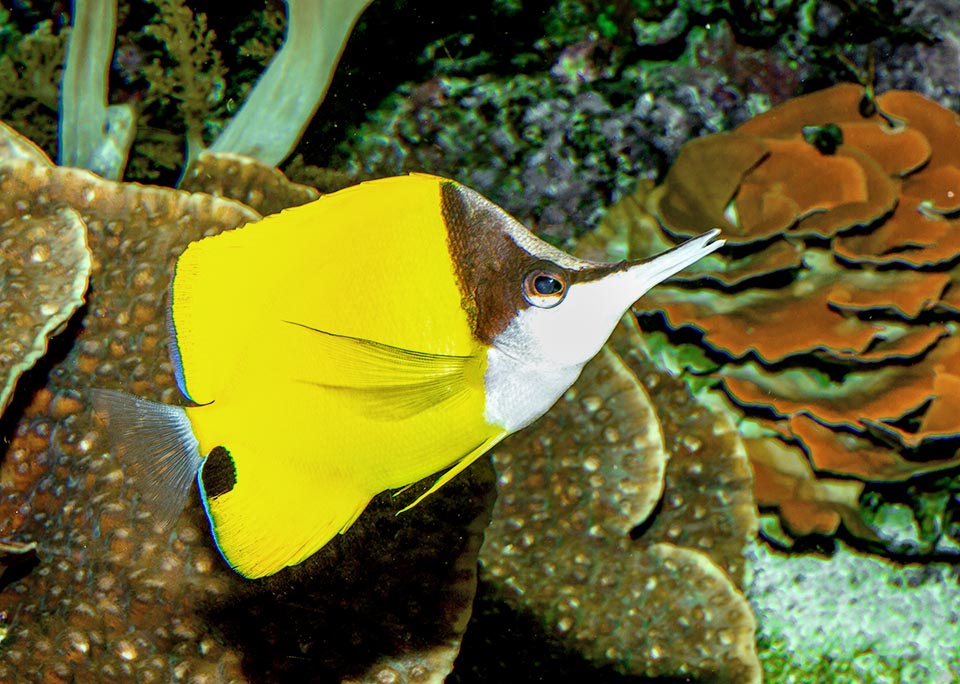
It can reach 18 years of age and the adults, often living isolated, defend their small territory driving away the congeners with warning sounds © Giuseppe Mazza
The pectoral fins and the caudal are transparent, the dorsal and the anal end with an electric blue small border and this last shows a round dark spot, close to the caudal peduncle, which may be mistaken as an eye by the aggressors.
In the island of Guam, belonging to the Marianas archipelago, they have found also completely black individuals and colourless specimens, with white head, a dark vertical band at the level of the operculum and an horizontal one crossing the eye extending to the snout.
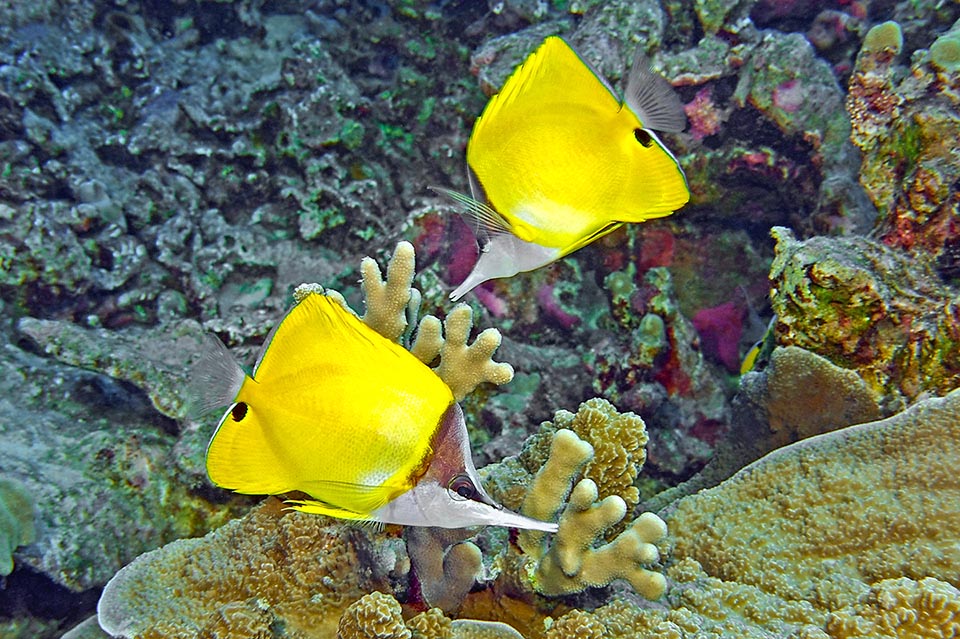
However to reproduce it forms relatively stable couples. The eggs are pelagic and the very slow growth of the eggs explains its vast diffusion © Barry Fackler
They are perpendicular to each other traits which can already be glimpsed in the bluish vertical band close to the brown triangle of the normal subjects and in the darker zones of the same.
Ethology-Reproductive Biology
The Forcipiger flavissimus has a very varied diet based on small benthic animals, especially crustaceans, but also hydroids, small fragments of polychetes, pedicels of sea urchins, eggs and larvae of other fishes.
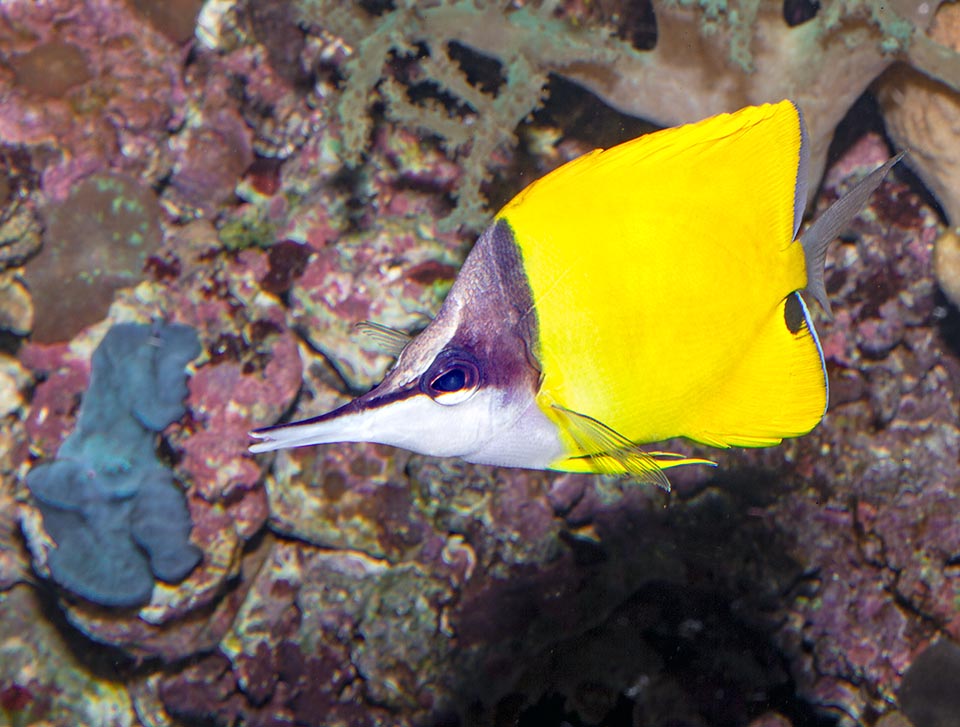
Even if ending very often in the aquaria, Forcipiger flavissimus is not an endangered species thanks to its diversified diet, the vast diffusion and a good resilience © G. Mazza
It lives solitary or in small schools, reaching the venerable age of 18 years. During the reproductive period pairs take form, which then will keep more or less stable. The eggs are pelagic.
The juveniles are very caught for the aquarium market, but the populations may double in less than 15 months and the diversified diet shelters them against the climate changes. The fishing vulnerability index is very low, only 12 on a scale of 100, and the Forcipiger flavissimus consequently appears as “Least Concern” in the IUCN Red List.
→ For general information about FISH please click here.
→ For general information about BONY FISH please click here
→ For general information about CARTILAGINOUS FISH please click here.
→ To appreciate the BIODIVERSITY of BONY FISH please click here.
→ To appreciate the BIODIVERSITY of CARTILAGINOUS FISH please click here.
